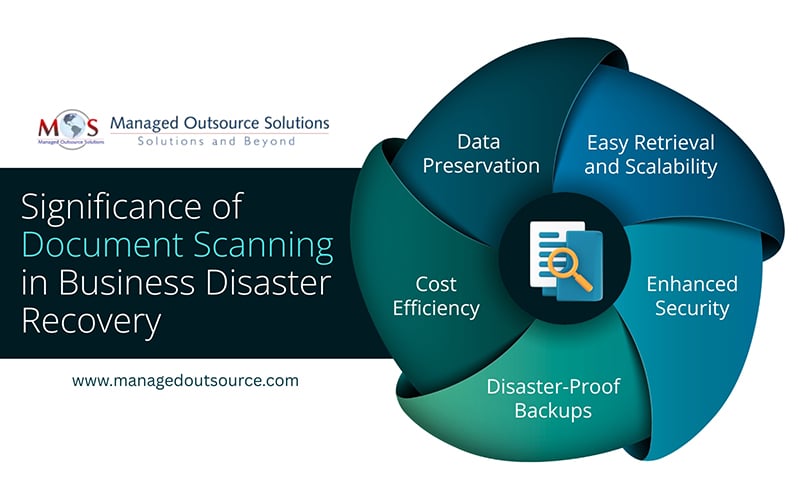Disaster in business comes in all forms – from cybersecurity threats to operational failures that disrupt a company’s workflow. Each catastrophe carries heavy consequences that affect multiple areas of an organization. For instance, a data breach in a healthcare setting can result in legal repercussions, lost revenue, and damaged reputation. The ripple effects of these disasters reach beyond just immediate results, sometimes even causing the shutdown of a company. To protect vital information and ensure business continuity, implementing document scanning in a disaster recovery plan is essential.
Having a well-prepared response strategy helps companies survive threats and minimize the impact of unexpected disasters. They must prioritize proactive measures to protect their business information assets. One effective way to secure the integrity and accessibility of physical records is by creating digitized versions. By investing in a document scanning for disaster recovery strategy, companies aren’t just converting paper into digital formats, but ensuring continuity and success of business when unexpected challenges arise.
Key Challenges in Disaster Recovery
Implementing a disaster recovery plan is more than just bouncing back after an adversity. An effective disaster recovery plan must minimize downtime, restore vital information, and ensure business continuity. Although insurance coverage can aid companies in terms of financial recovery, it doesn’t protect critical documents that are often housed in physical form.
Here are some of the key challenges that businesses face when disasters strike:
- Loss of Physical Records: Paper documents are highly vulnerable to natural calamities such as floods, wildfires, or even theft. If not digitized, the information contained in these documents may be permanently lost.
- Time and Efficiency: During a crisis, time is the key for any company to unlock the door to business restoration. However, locating, repairing, and storing physical documents even if they are in good condition can delay the recovery process.
- Compliance Issues: Certain industries are bound by legal rules and regulations to maintain and protect business information. If these documents are lost or damaged, it can result in legal and compliance complications.
- Financial Loss: The expenses associated with record recovery processes can cause financial strain, particularly if the business is already dealing with reduced revenues or downtime. If expenses outpace revenues for an extended period, it could lead to decreased customer trust, resource diversion, and financial instability.
However, businesses can avoid these aforementioned challenges by investing in paper to digital conversion for immediate access, secure storage, and long-term preservation. They can partner with a reliable document scanning company to transform their paper-based records into electronic format, ensuring valuable information remains intact and easily recoverable.
Why Businesses Need to Digitize Records for Disaster Recovery
As paper records are inherently vulnerable, digitizing essential documents is required to ensure business resilience, minimize impact of disasters, and promote regulatory compliance. Once scanned, documents are stored electronically, providing several key advantages that make them an essential part of any disaster recovery plan:
- Data Preservation: Scanning records and converting them into a digital format guarantees the long-term preservation of vital business information without degradation. Unlike physical records, digital copies are immune to damage from fire, water, or other disasters. They can be securely backed up, ensuring that critical data remains intact even in the face of unforeseen events.
- Easy Retrieval and Scalability: Scanned files can be stored in a centralized, searchable digital repository. During an emergency, instant access to data is critical to reinitiate processes and minimize downtime. Additionally, electronic files can be uploaded to cloud storage, eliminating the limitations of physical storage and providing greater flexibility for accessing and managing documents.
- Enhanced Security: In specific sectors such as healthcare or legal requires stringent security protocols to protect client information. By converting manual records into scanned files, organizations can protect their data with robust security solutions such as encryption, multi-factor authentication, and passwords.
- Disaster-Proof Backups: Digital documents can be securely backed up in multiple locations, such as on-premises servers and cloud storage, ensuring that redundant copies are safe in the event of a disaster. This approach enhances data availability, allowing teams to remain productive and access critical information, whether working on-site or remotely.
- Cost Efficiency: By digitizing documents, businesses reduce the costs associated with paper storage, physical file management, and security risks. The financial resources saved from eliminating paper-based systems can be reinvested into other critical areas of the business. Additionally, digital files optimize workflows, reducing time spent on manual document handling, which leads to increased productivity.
Best Practices for Document Scanning in Disaster Preparedness
Disaster recovery plans are vital for any company, but integrating document scanning can significantly enhance their business resilience. As each business has its own specific needs and challenges, aligning them with customized document scanning solutions ensures organizations can continue operating even in the face of a disaster.
Here’s how to do it effectively:
- Assess Your Current Document Storage and Needs
- Inventory: Identify which documents are critical to your business operations, legal compliance, and customer relationships.
- Prioritize: Determine which paper records need to be digitized first. For example, contracts, financial statements, employee records, and client correspondence should be top priorities.
- Choose a Scanning Solution
- Specialized Technology: Use specialized technology such as OCR to convert scanned images into searchable text. This makes retrieving specific information much easier.
- File Formats: Choose the right file formats for your documents. PDF and TIFF are popular choices for digital document storage due to their versatility and reliability.
- Scanning Equipment: Invest in high-quality scanning equipment, especially if you have large volumes of documents to digitize.
- Secure Your Digital Files
- Backup: Store your digital files in multiple locations, such as cloud-based systems, external hard drives, or offsite servers. Regular backups ensure that your documents are safe from cyber threats and hardware failures.
- Encryption: Implement encryption protocols to protect sensitive documents from unauthorized access.
- Access Control: Set up user permissions to control who can view, edit, or share scanned files. This ensures that only authorized personnel can access critical files.
- Establish Document Management Systems
- Centralized Repository: Store all digitized files in a central, searchable system for easy access. Many businesses opt for cloud storage, but on-premise solutions can also work.
- File Organization: Develop a consistent naming convention and file structure throughout your organization’s IT infrastructure to make it easy to locate specific records quickly.
- Employee Training: Educate employees on how to use the document management system. Ensure they understand how to scan, store, and retrieve digital files as needed.
- Monitor and Update the System Regularly
- Review: Periodically review your disaster recovery plan and document scanning processes to ensure they are up to date. As technology and threats evolve, and your plan should evolve with them.
- Update: When new records are generated, ensure they are scanned and added to the system regularly.
Preserve Business Records with Outsourcing Solutions
Document digitization solutions are essential for protecting against data loss during emergencies. They provide companies with access to professional tools and expertise, ensuring that documents are scanned accurately and securely. Outsourcing allows companies to easily manage growing volumes of records without investing in expensive equipment or training. With reliable backup systems and fast processing times, scanning service providers ensure that business continuity is never compromised during a disaster.





